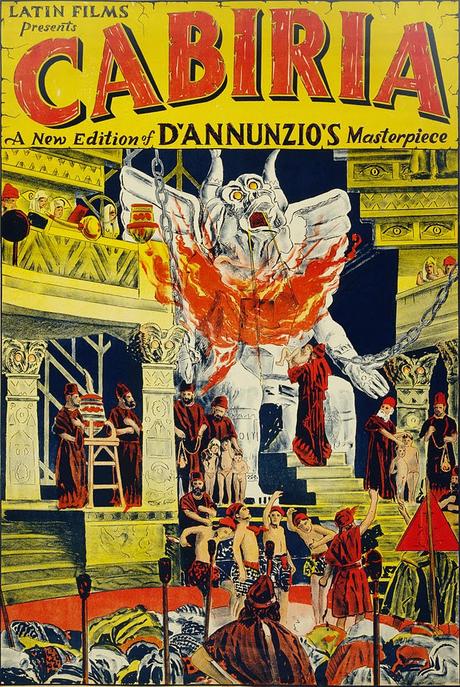
Directed By: Giovanni Pastrone
Starring: Italia Almirante-Manzini, Lidia Quaranta, Bartolomeo Pagano
Tag line: "The Master Work Of A Master Mind"
Trivia: Was the first film to use a dolly-track system, the effects of which were pegged "Cabiria movements" in the industry
Years before D.W. Griffith directed Birth of a Nation and Intolerance, Italy was already making movies on a grand scale. Films like The Last Days of Pompeii (1908), Lucrezia Borgia (1910) and Quo Vadis? (1912) set the standard by which many later historical epics, both in Hollywood and abroad, would be measured. Giovanni Pastrone’s Cabiria, one of the last produced during this era, was yet another impressive achievement, a motion picture so enormous in scope that its images are as awe-inspiring today as when it was first released over a century ago.
Set in the period of the Second Punic War (around 200 B.C.), Cabiria opens on the island of Sicily, where Roman aristocrat Batto (Émile Vardannes) resides with his wife and adolescent daughter Cabiria (Carolina Catena), who is cared for by a slave named Croessa (Gina Marangoni). When nearby Mt. Etna erupts, Croessa and Cabiria head for the safety of the countryside, where they’re kidnapped by Phoenician pirates, who sail to Carthage and sell the two to Kartholo (Dante Testa), a High priest of the God Moloch. Kartholo announces plans to sacrifice young Cabiria during an upcoming ceremony, causing a desperate Croessa to turn to Fulvius Axilla (Umberto Mozzato), a Roman spy operating undercover in Carthage, for help. Along with his slave Maciste (Bartolomeo Pagano), Fulvius rescues the girl, then heads to a local inn, where the Innkeeper Bodosteret (Raffaele di Napoli) agrees to hide them from the throng of worshipers hot on their trail. Thus begins a decade-long adventure during which our heroes encounter everyone from the famed Carthaginian General Hannibal (also played by Émile Vardannes, who appears as Cabriia’s father) to Princess Sophonisba (Italia Almirante-Manzini) of Numidia, all the while hoping to one day reunite Cabiria with the mother and father she left behind.
Aided by its striking set design and remarkable costumes, Cabiria presents several gargantuan scenes, from the eruption of Mt. Etna that kicks the story off to Hannibal’s crossing of the Alps (complete with elephants). With the Punic Wars as a backdrop, we watch as the Roman Fleet is nearly destroyed in Syracuse thanks to the mathematician / inventor Archimedes (Enrico Gemelli), who, aided by humongous mirrors, was able to sink a number of ships; and marvel at the film’s various battle sequences, each more extravagant than the last Though the story’s focus never dwells far from its central characters or their plight (Fulvius makes his way back to Rome, joining the army in their fight against Carthage, while Cabiria, played as an adult by Lidia Quaranta, becomes a handmaiden for the Princess Sophonisba), Cabiria is, first and foremost, a movie spectacular, recreating a time in history when adventure was commonplace, then staging it all in as exciting a manner as possible..
